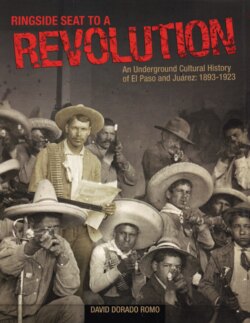Читать книгу Ringside Seat to a Revolution - David Dorado Romo - Страница 46
На сайте Литреса книга снята с продажи.
Оглавлениеwith a gun once in Sonora when she refused to stop
healing the sick and later in Clifton, Arizona when
Tomás refused to let Teresita marry the man of her
choice. On both occasions Teresita calmly stood her
ground until her father gave in. Furthermore, there
was no bitter breakup between Teresita and Aguirre,
which would have been expected if he was sur-
reptitiously using her name to support a
movement she didn’t believe in. On
the contrary, she left El Paso on
good terms with Aguirre and
would later name her first
daughter Laura in his honor.
It’s understandable why
Teresita would publicly
deny her involvement in
the border uprisings. She
feared for her safety.
Díaz had called for her
extradition. She was con-
stantly under government
surveillance. Rumor had it
that the Mexican govern-
ment would try to kidnap
her. She was the victim of
more than one assassination
attempt.
Yet there’s quite a bit of evi-
dence that suggests that Teresita was
much more involved in the insurrec-
tion than she was able to admit to
the press. Before the Teresista upris-
ings in the summer of 1896, Lauro
Aguirre hired El Paso photographer
Charles Rose to take pictures of Teresita. Aguirre
handed Rose a text that he wanted printed on the
back of the photograph. It was a short biographical
sketch of the young healer entitled “Señorita Urrea,
the Mexican Joan of Arc,” which spelled out Teresita’s
role in the movement to topple the Díaz regime.
Miss Urrea, during her first year of exile, said
nothing against the Mexican government;
but she did quietly help prepare for the
struggle against it. El Independiente, which is
written by her and Mr. Lauro Aguirre, has
attacked the injustices committed by the
Mexican government. Her great moral quali-
ties her love, unselfish dedication and the
truth of her denunciations against the
Mexican government make her the only per-
son who is able to transform the country of
Mexico. Only she can topple an oppressive
tyranny—that burns villages, exterminates
entire races and murders children.
We believe that she will overthrow the
actual government and will lead the Mexican
people to change their political situation. We
see her as the Mexican Joan of Arc. That
even the government of Mexico
sees her as we do is brought to
light by the tenacious manner
that it has persecuted her.
Miss Urrea has escaped
being assassinated or
poisoned on various
occasions.90
When Charles Rose
received the text, he was
reluctant to print it. The El
Paso photographer feared
that Aguirre had written this
without Teresita’s consent.
Rose approached Don Tomás
and told him he was afraid they
would all get in trouble for pub-
lishing such inflammatory material
on the reverse side of Teresita’s pho-
tograph. “I saw Mr. Urrea, and with
the help of an interpreter, I told him
that there may be some statements in
the document that the Mexican
authorities might find objectionable,”
Rose later informed the Mexican con-
sulate. “But he merely suggested that I leave my name
out of the document.”91
One of the dead Teresista rebels who was killed
at Nogales on August 1896 was carrying the photo-
graph of Teresita with the “Mexican Joan of Arc” text
on the back. Another was carrying a lock of her hair.
Still another dead revolutionary carried a letter read-
ing: “Brothers, continue to prepare yourselves for the
11th [of August, 1896] for we shall join you and lift
our voices together with you. Do not fear, for we will
enter into Sonora together. That’s why I say to you
that you must be ready. I will arrive at Nogales at
night. Peace be with you.—Teresita Urrea and John
the Baptist.”92 (John the Baptist may have been
Aguirre’s code name.)
The American authorities in El Paso kept close
watch on the Urrea home for signs of subversive
41
Teresita Urrea and puppy, ca.
1892. (Southwest Collection,
Texas Tech University.)
90
Lauro Aguirre, “Señorita Urrea, the Mexican Joan of Arc,” Holden Collection, Texas Tech University.
91
Brianda Domecq, “Teresa Urrea: La Santa de Cabora,” essay published in Jesús Valdés Vargas’ (ed.) Tomóchic: La revolución adelantada, p. 39.
92
Ibid., p. 41.
